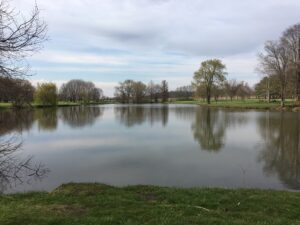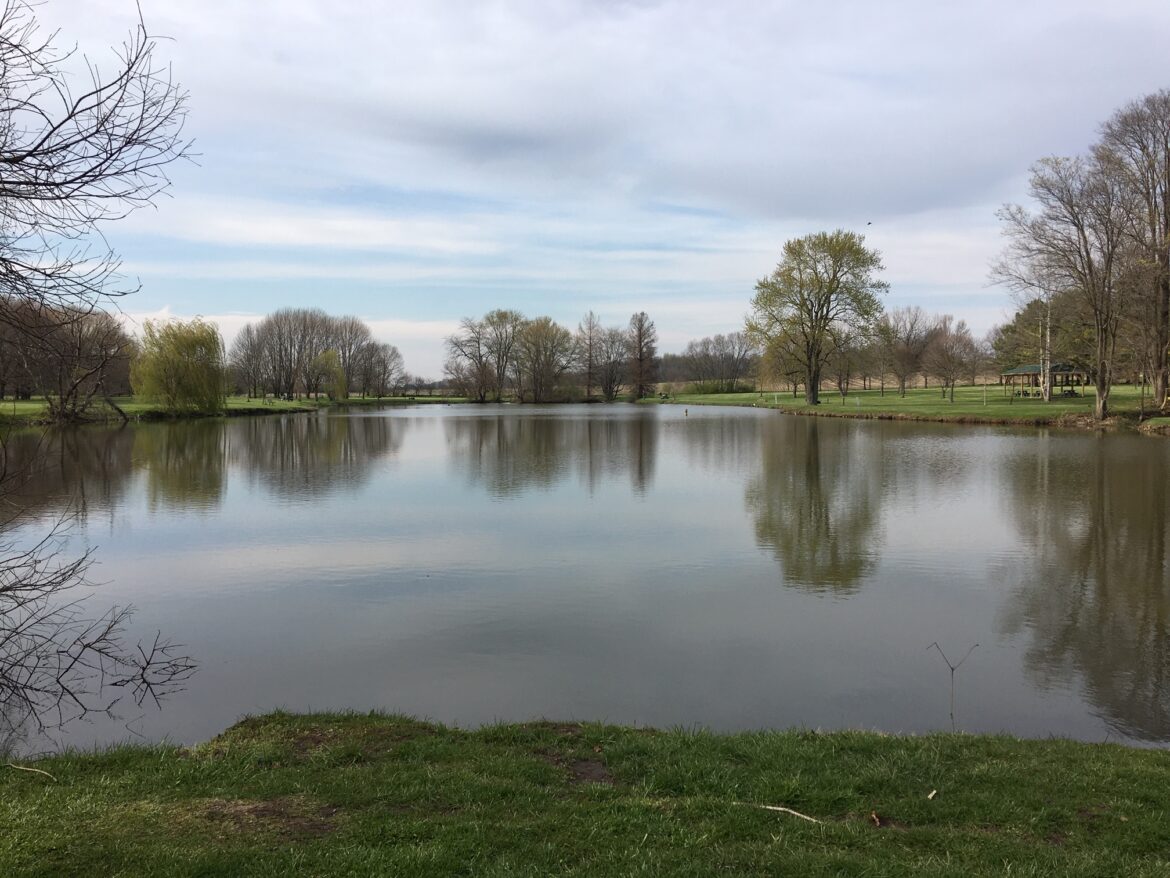 April 21st
April 21st
The 111th Day of the Year
You watch the afternoons of Spring across the river,
and you know that nothing only is or happens once,
and that our hearts spin like the Earth around the Sun.
bf
Sunrise/set: 5:50/7:21
Day’s Length: 13 hours 31 minutes
Average High/Low: 64/43
Average Temperature: 53
Record High: 84 – 1985
Record Low: 26 – 1904
Weather
Highs in the 80s come 20 percent of the days, 70s another 20 percent, 60s another 20 percent. Fifties occur 30 percent of the time, and 40s the final ten. The sky is overcast 50 percent of the time, and rain falls 50 percent of the time, too. Frost: one morning in a dozen.
Natural Calendar
Cross-Quarter Day, the day on which the sun reaches halfway to solstice, occurs at the end of April’s third week. This is the time the antlers of deer begin to grow. In average years along the 40th Parallel, the first parsnips bloom, and all major garden weeds are sprouting. Honeysuckles, the rose of Sharon and spice bushes have developed enough to turn the undergrowth pale green, and the high trees are blossoming and leafing: ginkgo, elm, tree of heaven, black walnut, pussy willow, box elder, sweet gum, ash and locust.
Redbuds and pie cherry trees blossom as pear petals come down. Hepatica sprouts new leaves as it comes to the end of its April cycle. Wood mint is at least eight inches tall, and sweet for tea. Wild ginger foliage has pushed up through the mulch. Toad trillium, Jacob’s ladder and large flowered trillum are budded, some in bloom. Virginia bluebells and spring beauties still hold.
Daybook
1982: The red quince at the north corner of the yard opened today.
1983: Cascades habitat: May apples tall, some fully developed, toothwort, spring beauties, hepatica, rue anemone, Dutchman’s britches still in bloom. Some early white spring cress. Trillium grandiflorum is almost opening.
1985: Cascades habitat, after ten days in the 70s and 80s: First wild geranium, wild ginger, sedum, wood betony, and golden alexander. Toad trillium, Jack-in-the pulpit, early meadow rue, ragwort full bloom. At home, the first thyme-leafed speedwell in the lawn.
1986: Cardinal sings at 5:05 a.m.
1987: Asparagus is up four inches. Redbud finally opens in the Glen. First garlic mustard blooms, first wild phlox, first white violets.
1988: Daisies budding now.
1989: The redbuds are open in Xenia, a few days ahead of Yellow Springs. First strawberry flowered today. More and more crabs are flowering. Mrs. Bletzinger talks about the great chanting of frogs and toads, their migration to the neighbor’s pond, but not to hers this year. Purple violets early full, the first yellow violets open, tree line thickening with blossoms, magnolias leafing on the south side of Wesley Hall, flowers holding on the north. Tulips still full bloom, daffodils late but holding. Everything happening so quickly, the sub-seasons over in a week or two, blend into other segments of seasons.
1991: Wisconsin to Yellow Springs: First white clover seen near Indianapolis. Above Janesville, the land is orange and gold with buds in the middle patches of pale green. Huge stretches of dandelions 60 miles south of Madison – the furthest advance north of the Great Dandelion Bloom. Forsythia blooms 15 miles further.
1992: Cowslips still in full bloom across from the Covered Bridge. Bradford pears leafing. Redbud three days out. Patches of green in the high trees across Yellow Springs valley.
1993: First killdeer noticed on Wilberforce-Clifton. Ferns just starting to unravel in the yard.
1995: One hundred and twenty miles north of Yellow Springs in Norwalk, Ohio, one azalea in full bloom against the doctor’s office wall. Northern Ohio daffodils are in full bloom, whereas ours in Yellow Springs are gone except for the late varieties. The fritillaria against the east wall opened today. Tonight in the warmth, the first ichneumon of the year stumbled about the living room.
1999: The toad cried in the rain at 5:08 a.m. Earlier, the frog barked. White bleeding heart early full, red bleeding heart early, small tooth-leafed bleeding heart full, dead nettle full, earliest tulips gone, some of the mid-season tulips are wilting as well. The first ferns have green nubs, knotweed three-feet plus.
2000: Redbuds still early bloom, apples hold in the cool rain. Honeysuckle leaves are shutting off the back yard from the street, maybe two-thirds of the way so far. The north side ferns are just starting to unravel. Cowslips along Grinnell declining.
2001: Today in the rain, the April green is so exquisitely bright: the great pubescent green of the world, the transfiguration of the earth, its shining garments.
2004: In Dayton, the first patches of dandelions have gone to seed, moving the area into the final phase of Middle Spring. At home, the first small pink azaleas are starting to open, and the new crabapple tree has just begun to flower.
2005: Celandine and fleabane, dogwoods, too, are starting. Some one-inch creeper leaves. Oak leaves some one to two inches, the scarlet and red oaks and rose of Sharon just pushing out. Hosta to about a foot tall. Green frog seen in the garden pond. Many maples and box elders a third to a half fully leafed.
2008: First celandine seen in flower today by the stone wall. Redbuds reddening, dandelions reaching full bloom throughout town. Lil’s maple and all the other maples on the block are leafing and flowering. Peaches and pears full. The south ash and the hackberries are also coming in. Nate’s black walnut and Moya’s both have distinctive, fat, dark bud clusters, but Don’s tree shows no sign of blooming. Daffodils are starting to decline now, but in the South Glen, a new twinleaf had opened. Toad trillium had developed its red flowers. Violet cress and toothwort were still strong. Foliage of wild geranium and wild phlox was appearing, ragwort budding.
Along the east border of the yard, the white bleeding hearts have finally come up, and an old pink bleeding heart emerged over night next to the new ones. A few ferns are a couple of inches tall, but most are still just slightly swelling and showing no green. Cowslips along Grinnell still full. The television news showed a full-blooming dogwood as a backdrop for a local political story.
2009: Two of Greg’s lily-of-the-valley have unraveled to reveal green buds. In the garden, variegated knotweed is up, flushed red, some stalks six inches. Endless summer hydrangeas have started basal leaves. Early Judd-type viburnums are in full bloom in Wilmington.
2011: Bright sun after days of rain and clouds, titmice and song sparrows calling loud, grackles all over, white birch and mall river birches with catkins, red mulberry, white mulberry, sweet gum leafing, more lilacs blooming, just a hair ahead of the apples. Lil’s maple in flower. From Goshen, Indiana, Judy writes: “Bill and I saw bloodroot, Dutchman’s breeches, spring beauties, early rue, and toad trilliums beginning to bud. May apples aren’t up very far. Violets aren’t out yet except here and there in our back yard. The forsythia are blooming, and a few daffodils, but the large bunches are still in bud. The hellebore, however, is magnificent.”
2012: Many roadsides covered with brown maple seeds.
2013: Another sunny but cold day. Still, the sidewalks along Dayton Street are lined with the fallen petals from the serviceberry trees, and the very first violet lilac opened above the pond. Don’s pie cherry is in full bloom like our sweet cherry. Paulownia tree buds have become enlarged over the past few days, should be ready to leaf when the weather warms. A few allium in the circle garden have buds. More zinnias planted around the yard. Fed the fish, and they actually left their hideout to move around the pond, first time this year. The birch at Lawson Place has bright catkins now.
At the Kennedy Arboretum and Ellis Pond, the yellow poplars have one-inch leaves, scarlet oak and sawtooth oak buds are just breaking out, the chestnut oak a little ahead of them. Red oaks are leafing, have small half-inch leaves. Shingle oaks have tiny catkins. Hackberry in full flower, garlic mustard heading up. The ashes are flowering, pecans beginning to leaf. Willows and sugar maples have one-inch leaves.
2014: Walking through the neighborhood, Bella and I found mid-season daffodils and tulips in full bloom, and one broad-leafed azalea starting to flower.
2015: Hard wind today, temperatures in the 50s. I dug more annual beds, transplanted the evening primrose and the Shasta daisies. Squills, yellow daffodils, grape hyacinths and pachysandra all ended their bloom season at about the same time a day or so ago.
2016: First annual beds dug. Late daffodils, windflowers and glory-of-the-snow and tulips still hold.
2017: Spain: To Olivieroa just thirty kilometers from Muxia and the ocean. More large landholdings throughout, much hay cut and to be cut, large tractors plowing. The vegetation thins with the altitude and the change in soil and the increase of agribusiness. Some stone outcroppings have appeared in the hills. As the landmarks recede with the differences in land and land use, so does the season become thinner and less clear.
2018: Keuka Lake, New York: The sun shines and the cold retreats. A mourning cloak butterfly came past as I was taking photos of the lake cottage. From Goshen, Indiana, Judy writes: “We went on a mile or so hike, following our local wildflower guru. He pointed out that we are two weeks behind last year, but that last year was abnormal. At this time in 2017 he found 15-17 species, but this year was more sparse. We found: spring beauties, cutleaf toothwort, purple cress, false rue anemone, Dutchman’s breeches, harbinger of spring, hepatica, leaves of trout lilies and violets but no buds yet, true rue anemone, bloodroot, and ramps. We also found the beginning of puttyroot, a native orchid that blooms around August. Rather skimpy, indeed!”
2019: The first bamboo shoots are up about three inches. Tiny buds on the peonies. Crab apple trees blossoming, pears still full. Full blush on the redbuds. Leslie says she saw three red-admiral butterflies chasing each other and two red-breasted nuthatches. At John Bryan Park, bluebells dominate the high path, wild phlox, bellwort, ragwort, spring beauties, bluets, toothworts here and there. The highest trees are pale green, and it is perfect late Middle Spring. From Madison, Wisconsin, Maggie reports the first May apples are up, first Dutchman’s britches and Virginia bluebells blooming.
2020: In the fields around Ellis Pond, red-stemmed cressleaf groundsel, about a foot tall, has just started to open, about on time to measure the approach of Late Spring.
Surely
there is a great Word being put together here.
I begin to hear it gather in the opening
of the flowers and the leafing-out of the trees,
in the growth of bird nests in the crotches
of the branches, in the settling of the dead
leaves into the ground, in the whittling
of beetle and grub, in my thoughts,
moving in the hill’s flesh.
Wendell Berry


